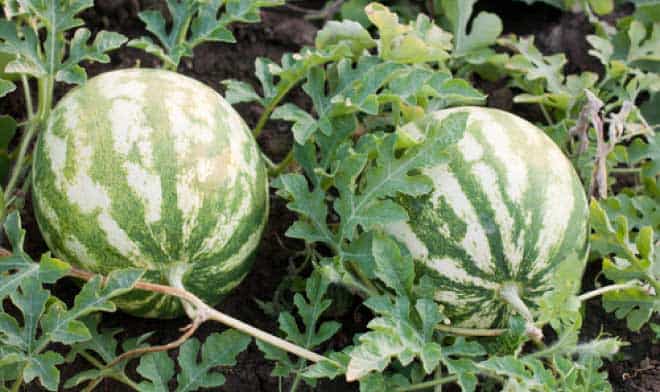Citrullus vulgaris

|
|
Citrullus lanatus Common Names: Egusi melon Scientific
Classification Kingdom: Plantae Clade: Tracheophytes Clade: Angiosperms Clade: Eudicots Clade: Rosids Order: Cucurbitales Family: Cucurbitaceae Genus: Citrullus Species: C. lanatus Synonyms: Anguria citrullus Mill., Citrullus battich Forssk., Citrullus vulgaris Schrad., Cucumis citrullus (L.) Ser., Cucurbita citrullus L., Momordica lanata Thunb. Morphological Description Citrullus lanatus is an annual, scrambling, and trailing vine-like plant, with
stems up to 4 meters long, occasionally reaching 10 meters. Its key
characteristics include: · Stems: Hairy, climbing with tendrils or trailing along the ground;
green when young, becoming woody with age (Fern, 2024). · Leaves: Deeply lobed, pinnatifid, rough-textured, 5–20 cm × 3–15 cm,
with 3–5 lobes; hairy beneath, petioles 2–10 cm (Prance & Jongkind, 2015). · Flowers: Yellow, unisexual, monoecious (male and female on the same
plant), 2–3 cm in diameter; male flowers with 3 stamens, female flowers with an
inferior ovary (Kew Science, n.d.). · Fruit: Large, spherical to oblong pepo (15–60 cm), with a smooth,
hard rind (green, yellow, or striped); flesh red, pink, or yellowish, juicy,
with numerous black or brown seeds (Fern, 2024). Distribution and Habitat Citrullus lanatus likely originated in Africa, with evidence suggesting
domestication in the Kalahari region, and is now cultivated globally in
tropical and temperate zones: · Geographic Range: Native to tropical Africa (Senegal to
Ethiopia, south to South Africa); widely cultivated in Nigeria, China, India,
and the Americas; Nigeria is a key producer in West Africa (Kew Science, n.d.). · Habitat: Thrives in well-drained, sandy loam soils with pH 6.5–7.5;
prefers full sunlight and annual rainfall of 500–1,500 mm; grows in savannas,
farmlands, and disturbed areas at elevations up to 1,850 m (Fern, 2024). · Ecological Role: Attracts pollinators like bees; seeds are
dispersed by animals and humans; can become weedy in disturbed areas (Burkill,
1985). Ethnopharmacology Citrullus lanatus is extensively used in West African traditional medicine,
with pharmacological studies validating several applications (Wahid et al.,
2022): · Antidiabetic: In Nigeria, seeds are used to manage diabetes. Globulins
from seeds (275.34 mg/g dry matter) reduced blood glucose by 88–137.8% in oral
glucose tolerance tests in rats, indicating significant anti-hyperglycemic
activity (Teugwa et al., 2013). · Antispasmodic and Bronchodilator: In Nigeria, seed decoctions treat asthma
and diarrhea. Ethanolic seed extracts relaxed isolated rabbit jejunum and
trachea, showing antispasmodic effects via calcium-mediated signaling, with
rutin and quercetin binding to voltage-gated calcium channels (Wahid et al.,
2022). · Anti-inflammatory and Analgesic: In Nigeria, fruit rind is used for pain
relief. Methanolic rind extract (400 mg/kg) inhibited writhing reflex by 66.45%
in mice, comparable to diclofenac (82.91%), and reduced paw edema by 46% (Omokhua,
2018). · Anti-urolithiatic: In Nigeria, pulp is used for kidney
disorders. Ethanolic pulp extract reduced calcium oxalate crystal counts in rat
kidneys and urine, increased urine pH, and improved creatinine clearance,
supporting use for urolithiasis (Siddiqui et al., 2018). · Antioxidant: Seeds and pulp are used to combat oxidative stress.
Methanolic seed extracts showed significant DPPH scavenging (60.05% at 1
mg/mL), attributed to phenolic compounds like quercetin and kaempferol
(Babatunde et al., 2019). · Laxative: In northern Sudan, seeds are used as a laxative. Roots
exhibit laxative and emetic effects at high doses, supporting traditional use
(Wahid et al., 2022). ⚠ Toxicity Profile: Citrullus lanatus is generally safe for consumption, with no
widely reported toxic effects at therapeutic doses. Acute toxicity studies
showed no mortality in rats at methanolic seed extract doses up to 2,000 mg/kg.
The sprouting seed embryo contains a toxic substance, but this is neutralized
during maturation. High doses of root extracts (>1,000 mg/kg) may cause
emetic effects. Use is contraindicated in pregnancy and for children due to
insufficient safety data. Potential heavy metal contamination in wild-harvested
plants requires caution (Fern, 2024; Wahid et al., 2022). The plant contains a number of potentially toxic
compounds and can be harmful if used in quantity. These compounds include
elatermidine, glycosides, resin, dihydric alcohol, heltiacontane, citrullin and
citrullinic acid. Taken in excess they can cause gastrointestinal pain,
diarrhoea, vomiting, hypothermia, cardiac disorders, cerebral congestion and
necrosis of liver and renal cells (Bnouham et al., 2006). Phytochemistry The bioactivity of Citrullus lanatus is driven by its diverse phytochemical
profile (Wahid et al., 2022): · Flavonoids: Quercetin, rutin, kaempferol, with antioxidant and
anti-inflammatory effects (Omokhua, 2018). · Phenolics: Gallic acid, chlorogenic acid, caffeic acid, enhancing
antioxidant and antimicrobial properties (Babatunde et al., 2019). · Alkaloids: Present in seeds, contributing to antispasmodic effects
(Wahid et al., 2022). · Saponins: Found in seeds and rind, aiding anti-inflammatory and
antimicrobial activities (Salawu et al., 2008). · Carotenoids: Lycopene, β-carotene, in fruit flesh, with cardiovascular
benefits (Fern, 2024). Additional Uses · Culinary: In Nigeria, flesh is consumed fresh, juiced, or used in
beverages; seeds are roasted, ground into flour, or used in sauces like egusi
soup (Fern, 2024). · Economic: Major crop in Nigeria, contributing to agricultural GDP;
global production led by China (46.6 million tons annually) (Kew Science,
n.d.). · Cultural: In Nigeria, watermelon symbolizes hydration and hospitality,
often served at communal gatherings (Burkill, 1985). · Industrial: Seed oil, rich in oleic and palmitic acids, is used in
cosmetics and pharmaceuticals (Babatunde et al., 2019). References
External Links More Pictures |
|
| Compounds of Citrullus vulgaris | |
| References |